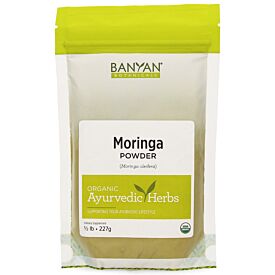Moringa Oleifera—A Superfood for All Ages
If you have lived in India or traveled to India, you may have overlooked one of the most nutritious plants around. Moringa grows plentifully in India—in home gardens or as natural fences. The fruit or seedpods, often referred to as drumsticks, are commonly used in the South Indian dish, sambar, as well as other dishes. Many people in India grow up not realizing the power of this seemingly ordinary plant.
Moringa powder, made from the leaves of the Moringa oleifera plant, hits headlines over and over again for its superb nutritious content. Rightly so—it truly is a superfood. The leaves, in particular, are exceptionally nutritious.
For instance, per 100 grams (or 1.25 cups) of the dried leaves, the plant often has up to 2500 mg of Calcium (versus 276 mg in a glass of whole milk),1 up to 40 mg of iron (versus 0.81 mg in a cup of spinach),2 up to 200 mg of Vitamin C (versus 112.9 mg in an orange),3 and up to 2500 picograms of Vitamin A (versus 1069 in a cup of chopped carrots).4
Next, let’s talk about protein. Protein constitutes 80–90% of all organic substances in the animal body. Which amino acids are present becomes very important when looking at protein quality, especially the eight essential amino acids that cannot be made by an animal.
In one study, seventeen total amino acids were found in the moringa plant. In fact, almost 70% of the leaf was protein, which is quite extraordinary for a plant. Further, 28% of the leaf is essential amino acids—even rarer.5
It is then no surprise that people are going crazy over moringa and its benefits. This plant, largely due to its nutrient content, is helpful for sleep, the heart, kidneys, liver, blood, and the pancreas. In fact, many health organizations around the world are advocates of growing this plant to help with childhood nutrition, especially in regions where starvation is a serious issue.

But What Is Ayurveda’s Take?
How has this amazing plant been used in the classical tradition?
Moringa is said to have a heating energetic effect, and its taste is heating as well as bitter. The plant carries the qualities of being light, dry, sharp, and fluid. It logically makes sense, based on these qualities and energetics, that the plant has significant detoxifying and cleansing effects, particularly for the blood and fat tissues.
In fact, in a historic textbook of Ayurveda, Bhava Prakash, moringa is called sigru (moves like an arrow), and described as deeply and rapidly penetrating tissues, even to the depth of the bone marrow for deep cleansing.
Yet moringa has the unique and mysterious effect of also being a tonic at the same time that it is detoxifying. After cleansing, the plant strengthens the heart and blood, for instance, to function optimally.
Overall, moringa is said to reduce kapha and vata. It will pacify vata, but only when taken in moderation. Because of the light, dry, sharp qualities it can aggravate vata if used in excess. Use cautiously, of course, with pitta imbalances as it does have a heating effect.
How to Use It
People are loving this superfood as an addition to their smoothies or nutritional shakes, or as a nutritional boost to food, like a bowl full of oatmeal. Get creative!
Additionally, you can try taking it more traditionally. For instance, for overall tonic and nutritious benefits, take with a teaspoon of ghee. For more metabolic benefits, take with a teaspoon of honey.
To help offset the heat or even the vata-aggravating qualities, take with a warm glass of milk with some additional honey. Or you may simply take it with a spoon of aloe vera to more directly assist in off-setting the heating quality.
NOTE
The numbers presented in this article are based on averages as calculated in scientific papers, and not from Banyan Botanicals’ own testing. We are presenting these averages to account for mild variation that naturally occurs from harvest-to-harvest or crop-to-crop. Based on our review of farming practices and our own limited testing, we have no reason to believe our product is inferior to the plants tested in these papers.













